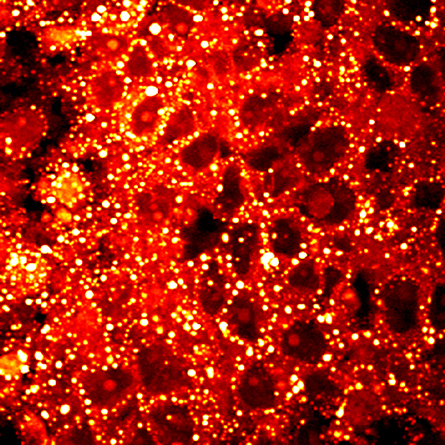From the journals: JLR
Great strides in lipidomics. How oxysterols affect immunity. When lipid profile meets lipoprotein metabolism. Read about these papers recently published in the Journal of Lipid Research.
Great strides in lipidomics
Lipid metabolism plays an important role in keeping a body healthy. Inside all living organisms, intricate networks of biochemical pathways help generate various lipid molecules and control their interactions with other cellular biomolecules. Studying these dynamic processes helps us understand their normal function and how dysfunctionality leads to diseases. The field of lipidomics covers the complete study of lipid biochemistry, spanning from biogenesis to metabolism, using the advanced techniques of mass spectrometry, or MS.

ester in lipid droplets (bright dots) in aggressive human prostate cancer.
For more than a century after lipids were identified, before appropriate technology was available, structural analysis of lipid molecules and study of their metabolism were extremely challenging. With the invention of advanced techniques, the field has bloomed. In their introduction to a recent thematic review series in the Journal of Lipid Research, Xianlin Han of the University of Texas Health Science Center at San Antonio and Richard Gross of Washington University write about advances in lipidomics from the field’s beginning in the 1980s to its current state and prospects for the future.
Han and Gross discuss the structural complexities of lipid molecules and their diverse structural and functional roles inside the cells. Historically, various analytical methods including chromatographic techniques, MS using hard ionization techniques, nuclear magnetic resonance and spectroscopic analysis were used to analyze lipid molecules. The advent of soft ionization methods of mass spectrometry in the 1980s revolutionized the study of lipid molecules, as these techniques allowed easy detection and quantification of individual lipid moieties, thereby constituting the foundation of modern era lipidomics.
Since then, with tremendous growth in the field, researchers have been able to identify and quantify low-abundance lipid molecules, characterize various lipid moieties and their spatial distribution in subcellular organelles, and study the clinical aspects of lipid metabolism. In the future, researchers expect lipidomics to help to decipher cellular processes as an integral part of collective omic technology.
How oxysterols affect immunity
The role of cholesterol and related metabolites in immune responses is an interesting area of research since recent studies have suggested their emerging role in immune cell activation and function. Recent developments in lipidomic studies have helped decipher this relationship. Oxysterols are formed by the oxidation of cholesterol or its precursors, and research in recent decades has shown that oxysterols play critical roles in both innate and adaptive immune responses.
In a review recently published in the Journal of Lipid Research, William Griffiths and Yuqin Wang from Swansea University Medical School in the United Kingdom discuss the roles of a few oxysterols in the immune response against pathogens. The researchers highlight two oxysterols, 25-hydroxycholesterol and 7alpha,25-dihydroxycholesterol, that are involved in various immune responses. Activation of Toll-like receptors triggers the synthesis of 25-hydroxycholesterol by the macrophages to defend against infection by microbial pathogens. On the other hand, 7α,25-dihydroxycholesterol is involved in immunology by acting as chemoattractant to lymphocytes expressing G protein–coupled receptors and plays important roles in coordinating the action of various cells in secondary lymphoid tissues.
Researchers are just beginning to understand these roles of oxysterols in immunology. This knowledge will lead to future investigations about their roles in immunology, particularly in autoimmune diseases.
When lipid profile meets lipoprotein metabolism
High-density lipoprotein and low-density lipoprotein, or HDL and LDL, act as vehicles to carry cholesterol in the blood. To transport cholesterol between organs of the body, these lipoproteins bind with cholesteryl ester, or CE, the esterified form of cholesterol. The levels of HDL and LDL along with those of cholesterol and triglycerides in the blood are key risk factors of many cardiovascular diseases, so researchers seek to understand the metabolism of these lipoproteins and how they regulate blood cholesterol levels.
In a recent paper in the Journal of Lipid Research, Richard E. Morton and Daniel Mihna of the Cleveland Clinic Foundation write that they studied the metabolism of lipoproteins by investigating factors that influence transfer of CE from HDL to LDL. Cholesteryl ester transfer protein, or CETP, transfers CE between HDL and LDL, while apolipoprotein F, or ApoF, inhibits the activity of CETP for selectively transferring CE to LDL. The researchers demonstrated that high blood cholesterol increases the level of ApoF, whereas elevated triglycerides decrease its level. They also found that the fraction of active plasma ApoF that is bound to LDL is increased in people with elevated cholesterol and reduced in people with elevated triglycerides, and they concluded that LDL size causes this difference.
Enjoy reading ASBMB Today?
Become a member to receive the print edition four times a year and the digital edition monthly.
Learn moreGet the latest from ASBMB Today
Enter your email address, and we’ll send you a weekly email with recent articles, interviews and more.
Latest in Science
Science highlights or most popular articles

Fueling healthier aging, connecting metabolism stress and time
Biochemist Melanie McReynolds investigates how metabolism and stress shape the aging process. Her research on NAD+, a molecule central to cellular energy, reveals how maintaining its balance could promote healthier, longer lives.

Mapping proteins, one side chain at a time
Roland Dunbrack Jr. will receive the ASBMB DeLano Award for Computational Biosciences at the ASBMB Annual Meeting, March 7–10, just outside of Washington, D.C.

Exploring the link between lipids and longevity
Meng Wang will present her work on metabolism and aging at the ASBMB Annual Meeting, March 7-10, just outside of Washington, D.C.

Defining a ‘crucial gatekeeper’ of lipid metabolism
George Carman receives the Herbert Tabor Research Award at the ASBMB Annual Meeting, March 7–10, just outside of Washington, D.C.

The science of staying strong
Muscles power every movement, but they also tell the story of aging itself. Scientists are uncovering how strength fades, why some species resist it and what lifestyle and molecular clues could help preserve muscle health for life.

Bacteriophage protein could make queso fresco safer
Researchers characterized the structure and function of PlyP100, a bacteriophage protein that shows promise as a food-safe antimicrobial for preventing Listeria monocytogenes growth in fresh cheeses.

